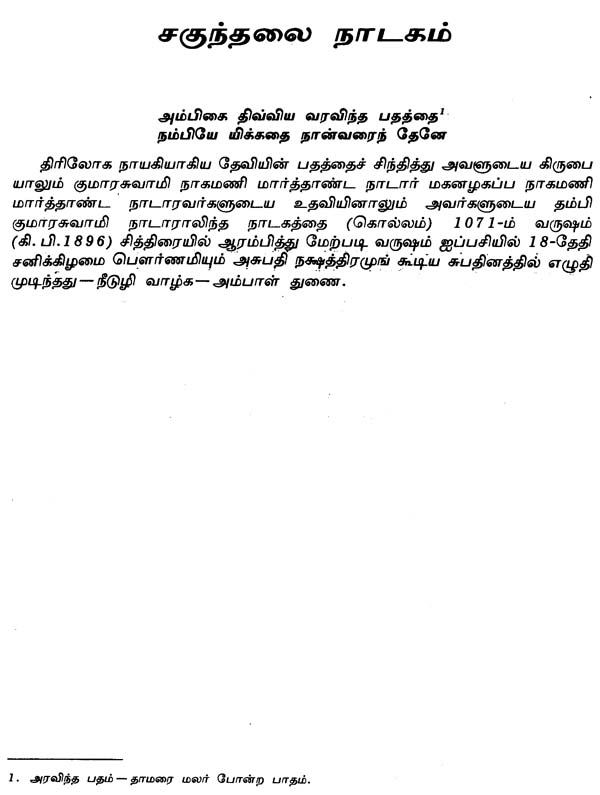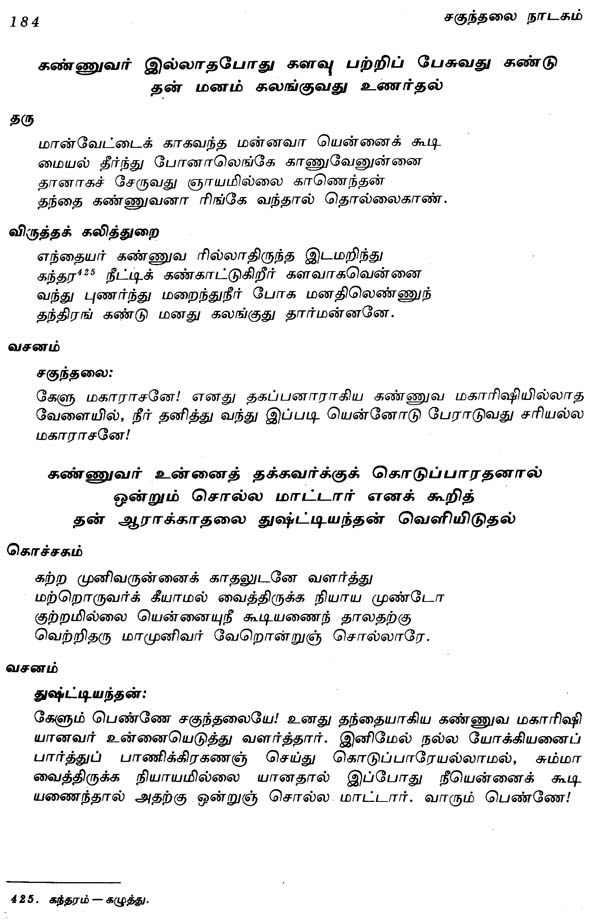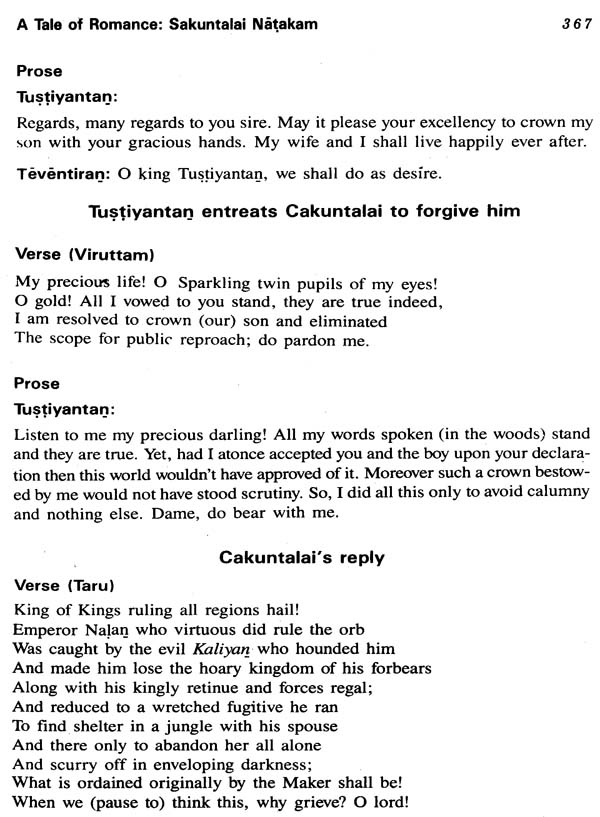
A Tale of Romance: Sakuntalai Natakam (An Old and Rare Book)
Book Specification
| Item Code: | NAY936 |
| Author: | A. Thasarathan |
| Publisher: | Institute of Asian Studies, Chennai |
| Language: | Tamil and English |
| Pages: | 377 |
| Cover: | PAPERBACK |
| Other Details | 9.50 X 7.00 inch |
| Weight | 700 gm |
Book Description
This play Sakuntalai Natakam is the only play extant in its original palm-leaf manuscript form which now is published with an appropriate English verse translation with footnotes and glossarial notes which shed light on the patois peculiar to Tamil of the native Kanyakumari district.
The Institute is indebted to Thiru N. Ramachandran Nair, who acquired this valuable palm-leaf manuscript to the Manuscripts Library of the Institute from Dr. Ramachandran, Professor in S. T. Hindu College, Nagercoil. Thiru K. Kumara swami, Deputy Commissioner of Commercial Taxes, (Rtd.), the son of the person who copied this play deserves the gratitude of this Institute for having handed over the valuable manuscripts to Dr. Ramachandran prompted by the passion to see that this play was brought to the notice of the Tamil scholars and those interested in Tamil studies, who could be reached by means of English translation.
Though there is no external evidence to prove the actual staging of this play, there are enough internal evidences which indicate to the performance of it. The flow of language, sonorous diction, literary embellishments, quaint songs which punctuate prose, the humour, and sizzling eroticism - the eroticism which captures the incandescent concupiscence of men whose repressed. Sensuality when aroused threatens to carry everything before their surging passion - all this have resulted in a piece of enjoyable literature. There are august celestials and awe inspiring sages; drop-dead ethereal beauties and their intoxicating loveliness and libido which are excitingly laid bare; side by side we are treated to the bluster and rodomontade of the Kattiyankaram and the whooping, wise, ancient midwife, characters straight out of the steaming sun baked earth of native deep south, whose tongue craks like whip thong and bubble with racy ribaldry.
Both in its literary motif and form, this play significantly deviates from Kalidasa's great masterpiece. But it has triumphed in its aim to capture an enduring saga from a great epic for regaling and edifying an unlettered folk population in the form of a folk play.
From the commentaries of the great Tamil classic Tolkappiyam we come to know that there existed two kinds of plays: verse plays in Tamil and plays translated into Tamil verse.' But none of them extant now. Translations and adaptions of Sanskrit plays and European dramas were a later day development that has enriched the Tamil literature significantly.
For centuries various episodes and personages of the epics the Ramayanam and the Mahabharatam have not only been regaling the masses but inculcating and reinforcing bhakti even beyond India. Poets and writers in all the Indian languages have extensively used themes from these epics, have spun engaging works of literary merit around ideas and ideals culled from them.
Abhijnana Sakuntalam, the immortal Sanskrit master piece of Kalidasa, was the earliest and most glorious adaptation of the saga of Dushyantan found in the Ati Paruvam of the Mahabharatam. Kalidasa's masterpiece has been faithfully translated into Tamil by Maraimalai Atikal2 and RA'. Ralcavaiyan-kar3 while Pavanantam Pillars Cakuntalai or Lost ring' is an adaptation of the Sanskrit play.
Towards the end of the 19th century several plays known as 'Periya eluttu natakankal were written in Tamil which bore the title Natakam or Vilacam. They were printed and staged. Plays such as Ariccantira Natakam, Alli Natakam, Aruccunan tapacu Natakam, Apimannan Cantai Natakam, Iravanan Cammara Natakam, Kama moccca Natakam, Kirusnan Natakam and Kicaka Natakam were churned out and commanded readers and audience. On this basis the story of Cakuntalai was crafted into a play. Towards the end of the 19th c. one Iramaccantira Kavirayar published a work titled Cakuntalai Vilacam. Around this time, this play had its birth in the Southern Cape Comorin area.
Cakuntalai Natakam in Palm-leaf Manuscript
This play under discussion Cakuntalai Natakam bears the Accession number 182 in the Manuscripts Library of the Institute of Asian Studies; it is This is further simplified in the prose exchanges where the patois and the peculiar idioms of the local folks crop their heads lending a quaint charm, peculiar flavour and piquancy.
This play is divided into 40 scenes. The personages are introduced by means of songs. Then they are seen speaking in verse and alternately in prose. It is not improbable to imagine that not only was this drama was composed to regale the reading public but also actually to entertain the unlettered who could really watch an enduring romance enacted before their eyes in a language within their understanding. In the scene II, we find the Pattar says.
nalamutan kacikan inrarul palaki
natikai cakuntalai natakattaip
pilatnutan patiyinkatita varamarul
perumal marukane namo nama"
Hail, hail you son-in-law of Tirumal
Do grant (us) the boon to sing and enact here gladly with verve
The play of lass Cakuntalai, the child of Kocikan.
This play, like any literary effort, is a child of its age. It can't help carrying the marks and imprints of the times which shaped it. It was made at a time when Tamil drama, after centuries of utter stagnation, was witnessing a revival. Religious discourses called Hari kathas and Kalakshepas were much in vogue and enjoyed immense popularity. Many Sanskrit expressions were liberally used in their discourses by their exponents. We find their verbal overtones in this play such as ako (Sans. Aho an ejaculation denoting surprise), Cuvami (Sans. Swamy - an expression bearing reverence), Tevarir (from Sans. Deva meaning deity or God). However, this play is essentially of Tamil milieu, is redolent of native Tamil earth of Kanyakumari.
The exchanges between Vicuvamittirar and Menakai, their amorous salvoes are sizzlingly erotic. And so are the passionate pleas of Tustiyantan to Cakuntalai. We do not see here the champion restraint of Kalidasa whose treatment of Dushyantan's virile ardour is informed by masterly delicacy of suggestion and gracious tenderness that temper the warrior's youthful exuberance and bridles his carnal rage. Tustiyantan, as he appears in this Tamil adaptation, strikes one as decisively more physical and is seen sweeping away the lass he is charmed by, with a veritable tornado of adulation, importunities and descriptive verse. Similarly, in the matter of repudiation too, Kalidasa's hero is not even remotely as ferociously castigating and vitriolic as Tustiyantan we see here. The king in this Tamil adaptation appears to enjoy sailing into his wife and torments her to distraction. But then, these redundancies and hamminess are characteristically folksy. And the author must have been certain that his characters `tearing a passion to tatters' would go down very well with his rustic audience, avidly lapping up what little amusement they could in those pre-cinema days.
Book's Contents and Sample Pages












